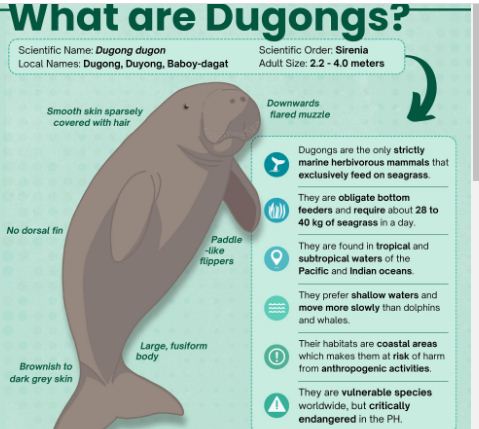November 19, 2025
Sea Cow : Conservation /Issue
Why in News ? A recent IUCN report released at the Conservation Congress in Abu Dhabi warns that India’s dugongs (sea cows) face a growing risk of extinction.
Key findings:
· Found mainly in the Gulf of Kutch, Gulf of Mannar–Palk Bay, and the Andaman & Nicobar Islands, their survival outlook is grim: long-term survival in the Gulf of Kutch is “highly uncertain,” conditions in the Andamans are “challenging,” and populations in the Gulf of Mannar–Palk Bay have significantly declined.

About Dugongs:
· Dugongs are listed as Vulnerable on the IUCN Red List and enjoy the highest protection in India under Schedule I of the Wildlife (Protection) Act, 1972, which bans hunting and trade.
· These gentle marine herbivores play a crucial ecological role by maintaining healthy seagrass meadows, which support biodiversity and store carbon.
· However, dugongs face numerous threats, including coastal habitat degradation, seagrass loss, fishing-net entanglement, boat collisions, pollution, and human disturbances.
· The Indian government has initiated conservation. Despite this, the new report indicates that urgent and strengthened action is needed to prevent their decline from becoming irreversible.
Dugongs: The Gentle ‘Sea Cows’ of the Coast:
· Dugongs (Dugong dugon) are large, gentle marine mammals often linked to mermaid legends due to their calm, graceful behaviour.
·Closely related to manatees, they have a rounded body and a dolphin-like tail. Adults can grow up to 10 feet long and weigh around 420 kg.
Exclusively herbivorous, dugongs feed mainly on seagrass meadows, consuming 30–40 kg daily — earning them the name sea cows.
· They inhabit shallow, warm coastal waters, typically in sheltered bays, lagoons, and estuaries less than 10 metres deep.
October 17, 2025
October 16, 2025
October 6, 2025
September 24, 2025
